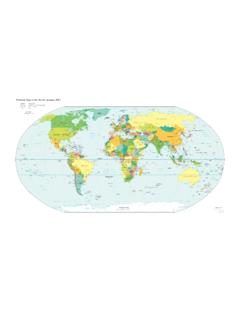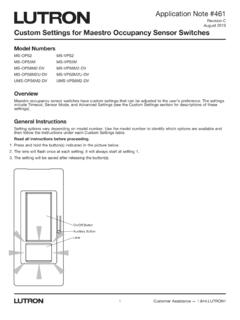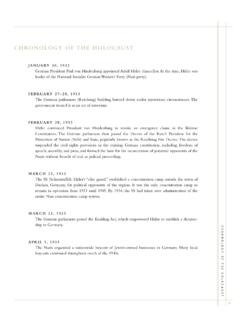Transcription of Timeline for World War II Japan
1 Unit 5: Crisis and Change Lesson F: The Failure of Democracy and Return of War Student Resource: Timeline for World War II Japan Timeline for World War II Japan Pre-1920: 1853: American Commodore Matthew Perry arrived in Tokyo harbor and forced the Japanese to allow trade with merchants with threat of military action. 1858: Western nations forced Japan to sign the Unequal Treaties. These articles established export and import tariffs and the concept of "extraterritoriality" ( , Japan held no jurisdiction over foreign criminals in its land. Their trials were to be conducted by foreign judges under their own nation's laws). Japan had no power to change these terms. 1868: Japan , in an effort to modernize and prevent future Western dominance, ousted the Tokugawa Shogunate and adopted a new Meiji Emperor.
2 The next few decades saw rapid and successful industrialization during the Meiji Restoration. 1899: With newly gained power from recent industrialization, Japan successfully renegotiated aspects of the Unequal Treaties. 1899 1901: The Boxer Rebellion led China to a humiliating defeat by the Eight-Nation Alliance of Western powers including the United States and Japan , ceding more territory, and dealing one of the final blows to the struggling Qing Dynasty. 1904 1905: The Russo-Japanese War began with a surprise attack and ended by an eventual Japanese victory over Imperial Russia. The Japanese took control of Korea. 1914: During World War I, Japan and other Allies seized German colonial possessions. 1919: Japan , as a member of the victorious Allies during World War I, gained a mandate over various Pacific islands previously part of the German colonial empire.
3 Japan joined the League of Nations. 1920-1938: 1922: The Washington Naval Treaty was signed, limiting the fleets and vessels of the navies of the United States, United Kingdom, Japan , France, and Italy. Japan was limited to about two-thirds of the fleet allowed for the United States and Britain. This was seen in Japan as a denial of Japanese equality amongst European powers. 1928: June 4: The Republic of China and Japan engaged in the Jinan Incident and the Huanggutun Incident. In the latter, Japanese agents assassinated the Republic of China's President, Zhang Zuolin. 1929: March 28: Japan withdrew troops from the Republic of China and ended the Jinan Incident. 1929: July 24: The Kellogg-Briand Pact went into effect. 1929: October 29: The Great Depression began.
4 1930: April 22: The United States, Japan , Italy, and Great Britain signed the London Naval Treaty, which regulated shipbuilding and submarine warfare. 1931: September 18: Japanese agents blew up part of the Japanese owned South Manchurian Railroad at Mukden in northeastern China, and blamed it as an act of sabotage by the Chinese forces. Using the incident as a pretext, the Japanese invasion of Manchuria was launched. Resistance failed, and, within six months, the occupation of Manchuria was complete. The incident was known as the " Incident" thereafter in China. It was marked by the Chinese as the start of the Japanese invasion of China. "Why We Fight", a US propaganda film released in 1942, claimed that World War II. started on this date, saying that "we should remember this date as well as December 7, 1941.
5 ". 1931: September 19: The Second Sino-Japanese War began when Japan invaded the Manchuria region in the Republic of China. 1932: January 7: The Stimson Doctrine was proclaimed by United States Secretary of State Henry L. Stimson in response to Japan invading Manchuria. Page 1 of 8. Unit 5: Crisis and Change Lesson F: The Failure of Democracy and Return of War Student Resource: Timeline for World War II Japan 1932: January 28: The January 28 Incident occurred when fighting erupted between Chinese boycotters and Japanese troops protecting the nation's enclave in the port of Shanghai. The Japanese dispatched a naval invasion force in an attempt to capture Shanghai. The unsuccessful invasion ended in a stalemate. In subsequent days, the League of Nations recommended negotiations between China and Japan , and Japan occupied Harbin, China.
6 By the end of February, Japan took control of Manchuria. China agreed to the League of Nations demand to stop fighting in and near Shanghai, but Japanese forces continued to attack until they left Shanghai in May. The United Kingdom and United States, which both have vast business and political interests in the city, brokered a cease-fire deal between China and Japan three months after the hostilities began. The Japanese naval forces withdrew. 1932: February 27: Manchukuo was announced as an independent nation, and was in reality a Japanese puppet government for the region of Manchuria. It encompassed the three northeastern Chinese provinces occupied by Japan since the " Incident.". Japanese control remained direct, and Japanese owned interests gained considerable power.
7 Additionally, the opium trade was encouraged. Manchukuo was not recognized by the League of Nations. Japan subsequently withdrew from the organization. 1932: March 6: China agreed to the League of Nations demand to stop fighting in and near Shanghai, but Japanese forces continued to attack Chinese positions. 1932: May: Japanese Prime Minister Inukai Tsuyoshi was assassinated by a group of young officers for his support of the London Naval Treaty. The act, known as the May 15. incident, was symptomatic of a certain level of anarchy among the Japanese aristocracy. 1932: May 15: Japanese troops left Shanghai. 1933: March 4: Troops of the 139th Division of Chinese 32nd Corps repulsed a Japanese attack on the Lengkou Pass of the Great Wall.
8 The provincial capital of Rehe Province, Chengde, however, was captured by Japanese troops without opposition. 1933: March 27: Japan withdrew from the League of Nations. 1934: March 1: Japan renamed Manchuria as Manchukuo. 1934: December 29: Japan renounced both the Washington Naval Treaty and the London Naval Treaty. 1935: December: Large-scale anti-Japanese riots took place in Peking. 1936: February: A coup attempt by junior officers came close to succeeding. 1936: May 9: Chiang Kaishek proclaimed that Japan was waging war in China without a formal declaration of war. 1936: October 20: Japanese-backed Mongolian troops attacked China. 1936: November 26: The Anti-Comintern Pact was signed by Japan and Italy. Japan joined Germany in signing the Anti-Comintern Pact, which was expected to provide a two-front threat to the Soviet Union.
9 However, Japan was not interested in being drawn into a European war, and thus the pact was not a true alliance. 1936: December 1: The Chinese Civil War temporarily ended, so the two sides could prepare for a full-scale war with Japan . 1937: Japan again invaded Manchuria (as it had in 1931) and China proper. Under the guise of the Greater East Asia Co-Prosperity Sphere, with slogans such as "Asia for the Asians!, the idea was to remove the Western powers influence in China and replace it with Japanese domination. Japan was determined to dominate this market of raw material and consumers. Page 2 of 8. Unit 5: Crisis and Change Lesson F: The Failure of Democracy and Return of War Student Resource: Timeline for World War II Japan 1937: July 7: The Marco Polo Bridge Incident occurred, which most historians regard as the beginning of the Second Sino-Japanese War.
10 Japanese forces conducting military exercises outside Yuan Peng County near Peking claimed that several Japanese soldiers participating in the exercise were not accounted for after the exercise. After the Japanese request to enter the Yuan Peng County town to conduct a search was declined by the Chinese, the Japanese launched an all-out assault towards Yuan Peng County. The Chinese government in Nanking declared its intent to resist Japan , marking the start of the Second Sino-Japanese War. The incident was later known as the " Incident" or the "Luokouchiao Incident" by China. Additional battles follow during the year, including the Battle of Shanghai (August 13-November 26) and Battle of Taiyuan (September 1- November 9). Japan established the puppet nation of Mengjiang in the Inner Mongolia region of the Republic of China.






